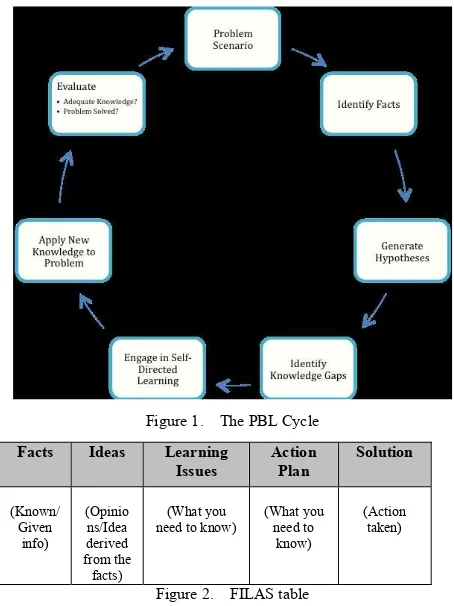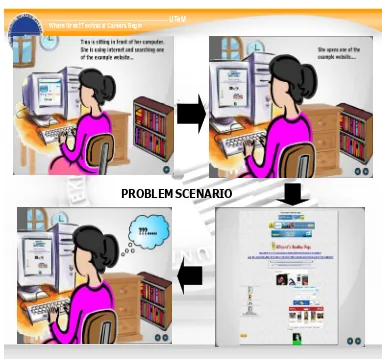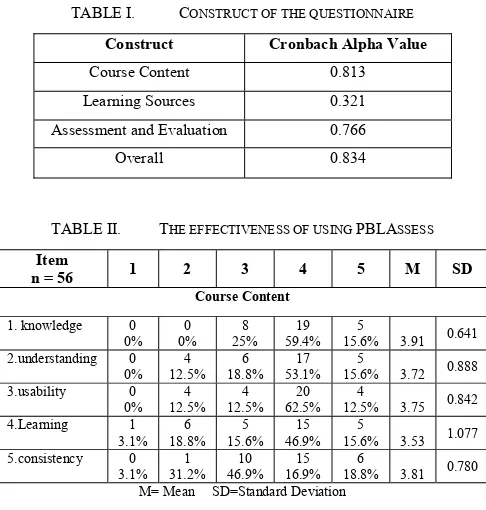ICT + PBL = Holistic Learning
solution:UTeM’s Experience
1
Faaizah Shahbodin
Interactive Media Department Faculty of Information and CommunicationTechnology
Universiti Teknikal Malaysia Melaka (UTeM) Hang Tuah Jaya, 76100, Durian Tunggal,
Melaka,Malaysia faaizah@utem.edu.my
²Mariana Yusoff,
3Che Ku Nuraini Che Ku
Mohd
²Centre for Languages and Human Development, 3
Faculty of Information and Communication Technology
Universiti Teknikal Malaysia Melaka (UTeM) Hang Tuah Jaya, 76100, Durian Tunggal,
Melaka,Malaysia
²
mariana@utem.edu.my, 3cknuraini@gmail.comAbstract - This paper highlights how ICT could be integrated in the process of teaching and learning in the Problem Based Learning (PBL) environment. The main focus is integrating the ICT components such as multimedia and internet technologies as a tool for PBL learning environment, and utilizing the PBL approach for the delivering instructions in the teaching and learning process at UTeM. This paper also shares findings on the effectiveness of PBLAssess which have been developed in this study. Fifty-six respondents (second year students) enrolled for the Human Computer Interaction course are selected for this study. Two research instruments are developed for the purpose of evaluating students’ performances and preferences which include a set of questionnaire and prototype known as PBLAssess. Further some of the current work on integrating ICT and PBL learning environment are also shared. Understanding both the current state of art for PBL and future prospects are the key issues in setting an agenda for future research and development in PBL.
Keywords: PBL; ICT; Learning Process; Multimedia; Internet
I. INTRODUCTION
Problem Based Learning (henceforth, PBL) and ICT have been the buzzwords in today’s education. These words hold the possibility of supporting active and student-centered learning. This possibility would be more interesting if both pedagogy and ICT tools are combined. In an increasingly complex world, learners of all
ages need to be able to grapple with the real life and ill-structured problems. Therefore, the learners need to be prepared for a lifetime of learning by utilizing PBL as it provides ample opportunities to learn through engaging with such tasks. Psychological research and theory suggest that by
solving ill-structured problems [2] [8] [11]. Students work in collaborative groups to identify what they need to learn in order to solve the problem. They engage in student-centered learning and apply their new constructive knowledge to solve the problem. In PBL, the role of lecturer or teacher changes to the role as a coach or facilitator, which aims to facilitate the learning process rather than to provide knowledge. The goals of PBL, among others, include:
i. Developing multidisciplinary knowledge
ii. Developing problem-solving skills and strategies. Discussing problems in a PBL group activates relevant prior knowledge and facilitates the processing of new information [10].
iii. Developing self learning skills. -Students can better construct new knowledge when they can relate to what they already know.
iv. Developing teamwork and collaboration skills – The ideal group consists of 3 to 5 students. Each group member must obey common ground, resolving any discrepancies, negotiating the actions that a group is going to and coming an agreement consensus [1]. This set of common rules requires an open exchange of ideas and engagement of all group members [4] [12]. v. Develop intrinsic motivation occurs when
learners work on a task for their own satisfaction, interest or challenge.
II. WHY USE PBL?
concepts are presented in the lecture format, and proceeds with the “end-of-chapter” problems. In PBL, student plays certain roles in solving a problem. For example, when the secondary school children were asked to understand human digestion process, they act as dieticians to advise the patient about healthy diet [6]. At several points in the problem, students typically pause to reflect on the existing knowledge or the data they have collected so far, generate questions about that data, and hypothesize the underlying causal mechanisms that might help to explain the solutions in hand. The students then identify the concepts that they need to learn and know more about to solve the problem (i.e., “learning issues”). After considering the problem with their ‘limited’ prior knowledge, the students divide task and independently research the learning issues they have identified. They then regroup to share what they have learned, reconsider their hypotheses and/or generate new hypotheses in light of their new learning, as shown in the PBL cycle (refer to Figure 1). When solving a problem, students reflect on the problem in order to abstract the lessons learned, as well as to reflect at how they perform in the processed of self-directed learning and collaborative problem solving.
Figure 1. The PBL Cycle
Facts Ideas Learning
Issues
Action Plan
Solution
(Known/ Given
info)
(Opinio ns/Idea derived from the facts)
(What you need to know)
(What you need to
know)
(Action taken)
Figure 2. FILAS table
Figure 2 shows the FILAS table. The FILAS problem solving step will be used throughout the PBL process. The acronyms:
F, I, L, A, and S stand for Facts, Ideas, Learning issues, Action, and Solution respectively. The Facts column holds information the students gather from the problem. The problem is then posed before the relevant information is provided through any medium, including texts or lectures, and about the subject matter underlying the problem. Ideas that could brainstorm continually lead to potential solutions after more information is gathered; in other words, a hypothesis is proposed. The Ideas column serves to keep track of evolving hypotheses about potential solutions. The students place questions into further investigation under the Learning Issues column. Throughout the discussion, students may pose any ambiguity questions, called as “learning issues” on the problem aspects which are not clear. These Learning Issues are recorded by the group. They are encouraged continually to define what areas they know and more importantly, what areas that they do not know. The Action plan is used to keep track of plans problem solving or find more information. A potential solution into the Solution column is then proposed. Finally, the coach or facilitator evaluates the proposed solution and share the solution with the students. This PBL cycle is repeated until the problem is resolved. In PBL, it is the problem that drives the learning. Traditional education and training is just the opposite, it is content driven. In traditional models, individuals learn hordes of information and often struggle to put it all together. A better approach is to give them a solid foundation that is anchored in problem-solving, decision-making, and self-directed learning. That is what PBL does which provides the anchor to our foundation. With PBL, learners apply knowledge, not just acquire it [9].
III. WHY USE ICT?
ICT plays an important role in supporting the learning process. Multimedia technologies and internet technologies are being increasingly used to provide learning resources, collaboration spaces, and support learners in PBL problem solving process, problem scenarios presentation, assessment, and reflection.
These technologies can also provide access to a vast array of information (including digital libraries), data for analysis, tools for organizing ideas (concept maps), present ideas and identity people who provide information, feedback and inspiration.
Multimedia and internet technologies are provided to support PBL in giving exciting curricula based on the real world projects and problems and bringing these problems into the context of the classrooms. The technologies also provide scaffolds, tools and resources to enhance learning, by giving both students and facilitators more opportunities for feedback, reflection which expand the opportunities for students to learn through collaboration and discussion. With the advent of technology-rich teaching on a larger scale, there are now many opportunities for creative and innovative teaching and new relationships both for students and the shifting world of knowledge. ICT provides possibilities for planning, information gathering, organizing, presenting and assessing performances. There are numerous tools which could be used such as PBL Planning form, PBL Wiki, online learning journals, Youtube, Facebook, SlideShare, moodle forum and Legobots.
IV. PBLASSESS:HOW ICT HAS BEEN INTEGRATED
The development process of PBLAssess includes the creation of the instructional materials. These instructional materials contain information that students had used to achieve the objectives. PBLAssess consists of five modules namely; a) Problem Scenarios b) Lecturer Module c) Problem Solving, and e) Exploration and Assessment. All the modules run online and consist of various multimedia elements such as animation, graphics, audio, video and interactivity.
A. Problem Scenarios
The problem scenarios serve as the organizing centre and a platform provided for the learning context. They are ill-structured and related to the ‘real-world’ issues. The effective PBL problems scenarios must engage the students’ interests and motivate them to probe deeper understanding of the concept being introduced. The problems should be complex enough to require the cooperation of all members to work together and produce possible solutions which are open-ended solutions. These problems are created in such a way to meet the learning outcomes of the respective courses. Figure 3 shows an example of problem scenario crafted in the teaching of the User Interface Design subject offered at Faculty of ICT in the Universiti Teknikal Malaysia Melaka [3].
Where Great Technical Careers Begin UTeM
PROBLEM SCENARIO
Figure 3. The problem scenario
B. Online collaboration
The asynchronous forum board is used in PBLAssess. Students, in a group of three to five students, are assigned to analyze and solve the problem. This is done by assigning the individual student to undertake the defined tasks. Using this communication tool, the learners actively constructed knowledge by formulating ideas into words with the ideas built upon the reactions and responses of other students. In other words, learning took place in an active and interactive environment. During the entire collaboration, the lecturer, who played the role of a facilitator, guided and monitored the entire collaborative processes. Figure 4 depicts the online collaboration that took place
.
C.Online resources
Each student had his/her own responsibility to conduct independent research on the learning issues that were assigned. He or she is required to resort to online resources for new information. On an individual basis, one had to attempt to find solutions, new information and concepts pertaining to the assigned learning issues. The independent study enables the student to critically synthesize and construct knowledge to bring resolution to the problem. The integration of online resources with PBL involved provides the links in the Learning Management System to the course resources available online, as shown in Figure 5. Students had to find and evaluate the broad array of online resources which are needed to resolve the learning issues.
Figure 5. Sample of the online resources
D. Problem Solving Process
The process of online research and follow-up online collaboration are repeated in a complete cycle until the group members are satisfied that they had addressed the learning issues and provided answers to the problem that was initially posed to them. The group collectively planned for the presentation the solution to the problem by utilizing the various online tools which are made available. There are various problem solving steps available and FILAS is one of method in PBL field [8] and been modified by [6] by adding “S” which stands for PBL solution. The sequence of problem solving process using the aforementioned FILA steps is shown in Figure 6:
Figure 6. FILAS Steps
V. METHODOLOGY AND FINDINGS
A total of fifty six students had enrolled for the Human Computer Interaction (HCI) course in the Semester 1 2009/2010. The User Interface Design (UID) topic which includes sub topics such as Cognition, Mental model vs. Conceptual model, User Interface Components and 3D interfaces was chosen as a prototype designed for the PBLAssess. A pilot analysis conducted based on the past semester performances had indicated that students performed poorly with the lowest standard deviation of 2.273 and mean of 3.66.
The research instruments used to collect data are questionnaire and development of prototype. A set of checklist questions is prepared based on three factors, namely a) course content, b) learning materials, and c) assessment and evaluation. The Prototype development is the creation of the first working model of a new product or invention. The prototype called PBLAssess is developed based on ADDIE model with the chosen topic, i.e User Interface Design (UID).
findings for effectiveness of using PBLAssess in terms of Course content can be seen in Table 2.
TABLE I. CONSTRUCT OF THE QUESTIONNAIRE
Construct Cronbach Alpha Value
Course Content 0.813
Learning Sources 0.321
Assessment and Evaluation 0.766
Overall 0.834
TABLE II. THE EFFECTIVENESS OF USING PBLASSESS
Item
This paper presents how multimedia and internet technologies are incorporated in the teaching and learning process in the PBL classrooms. This paper also shares findings on the effectiveness of PBLAssess. Further research need to be conducted to identify hindering and motivating factors when multimedia and internet technologies are incorporated into PBL classes. Deep study is warranted to examine the effectives of combining PBL and ICT. This combination holds benefits to students as they work in the richer context of the classroom rather than the conventional ones.
ACKNOWLEDGEMENT
We acknowledge the support from the Universiti Teknikal Malaysia Melaka through the short-term research grant no. PJP/FTMK/2010/S (15)789.
REFERENCES
[1] Barron, B.J.S. (2002). Achieving coordination in collaborative problem-solving groups. Journal of the Learning Sciences. 9, 403-437. [2] Barrows, H.S. (2000). Problem-based learning applied to medical
education. Springfield IL: Southern Illinois University Press.
[3] Che Ku Nuraini Che Ku Mohd & Faaizah Shahbodin (2009). Assessment techniques in PBL for teaching Human Computer Interaction. International Conference on Software Engineering and Computer System (ICSECS09), 19-21 Oct 2009, UMP, Pahang. [4] Cohen, E. G. (1994). Restructuring the classroom: Conditions for
productive small groups. Review of Educational Research, 64 , 1-35. [5] Donnelly, R. (2004b) “The Effectiveness of Teaching 'Online Learning' in a Problem-based Learning Classroom
Environment,” in M. Savin-Baden and K.Wilkie (eds.) Challenging Research into Problem Based Learning. Buckingham: SRHE/Open University Press.
[6] Faaizah, S & Halimah, B.Z 2009) Student learning processes using Hybrid Problem Based Learning in Science Classrooms. 2nd International PBL Symposium (PBL 2009) Republic Polytechnic, Singapore, 10-12 June 2009.
[7] Faaizah, S & Halimah, B.Z (2008). Hybrid PBL: C2HADAM Courseware testing result. Proceedings of the Joint Open and Working Conference: ICT and Learning for the Net Generation
(LYICT2008). Open University OUM, 7th -10th July 2008. [8] Hmelo-Silver, C. E. (2004). Problem Based Learning: What and
how do students learn? Educational Psychology Review, 16 , 266.
[9] Lepinski C. (2005). A New Approach To Teaching, Training &
Developing Employee. Problem Based Learning. Assistant Communications Manager.Marin County Sheriff’s Office.
[10] Schmidt, H. G., DeVolder, M. L., De Grave, W.S., Moust, J. H. C., & Patel, V.L. (1989). Explanatory models in the processing of science text: The role of prior knowledge activation through small-group discussion. Journal of Educational Psychology, 81 610-619.
[11] Torp, L. & Sage, S. (2002). Problems as possibilities: Problem-based learning for k-12 education, ed. Alexandria VA: ASCD. [12] Wenger, E. (1998). Communities of practice: Learning, Meaning



